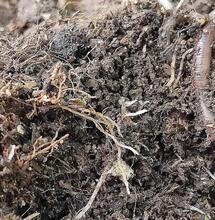Amino, Humic and Fulvic Acids in Cannabis Gardening

Organic matter is essential to creating a healthy growth medium; amino, humic and fulvic acid are three important components for vibrant plants. Their balanced presence in the grow medium can bring multiple benefits for your cannabis plants, such as stronger stems and roots as well as resilience to disease. In this article, read everything you need to know about amino, humic and fulvic acids, and how they are important in cannabis gardening.
What Are Amino Acids (AA)?
In the most basic sense, amino acids are the building blocks of proteins. Amino acids are the carriers of Nitrogen and enzymes, and they are also important in the photosynthesis process. A total of 21 amino acids are available to plants, affecting hormone, cell wall formation, and chlorophyll production, among other processes. Amino acids support growth, structure and yield as the plant transforms from seedling to mature crop. Which means that AAs also have a critical role in growth regulation. Another benefit is that they improve the soil and without them the soil would not have as many nutrients.
Research further shows that amino acids are directly responsible for healthier plants, robust stem and root mass, improved response to stress, and a balance of available Nitrogen going from the soil to the root system. During flowering, amino can help produce more resinous and aromatic flower bud sites, too.
How Do Cannabis Plants Make Use of Amino Acids?
Cannabis plants will typically use amino with humic and fulvic acids in order to build strong stem walls with thick cell walls that are difficult to get damaged by pathogens or insects. Imagine it as an elastic protective net that prevents the little critters to get an easy munch on the leaves or other plant material.
The second most important use is the conveyance of Nitrogen and other compounds through amino acids to various parts of the cannabis plants. Supplying amino acid to the soil will directly impact chlorophyll production and the overall state and color of the foliage.
What Is Humic Acid (HA)?
Humic acid is organic matter that is dark brown to black in color, which is water-soluble at more alkaline levels (pH >2). An organic catalyst, humic acid is derived from the organic components of soil, including humus or peat. HA is actually a by-product of the micro-herd that is responsible for breaking down dead organic matter; many different organic acids are formed when organic matter biodegrades, and humic acid is an intricate mixture of such acids.
An excellent soil conditioner due to its high molecular weight, humic acid is perfect for both soil and soil-less substrates, with regards to either supplementation or rejuvenation. The quality and efficacy of either dirt or soil-less media can be greatly increased by improving water retention and facilitating the movement of nutrients between soil particles, increasing the availability and even distribution of fertilizer.
A fantastic chelating agent, humic acid attaches itself to micronutrients, forming a composite that is more efficiently and easily absorbed by plants, promoting extremely high ion-exchange and buffering capabilities. Metallic elements such as magnesium, zinc, manganese, calcium and iron are absorbed more easily upon the application of humic acid, leading to an increase in both plant matter and root mass, including the formation of lateral or horizontal roots. This is true in biological (soil), hydroponic and aeroponic gardens.
What Is Fulvic Acid (FA)?
Fulvic acid is a water-soluble humic material of a light yellow to golden to yellow-brown color that carries a very low (acidic) pH but is soluble in all pH conditions. With a lower molecular weight than humic acid, fulvic acid contains a higher oxygen content but lower carbon than the high-molecular weight humic acid. Due to the low molecular weight of FA, the substance easily penetrates the leaves of the plant, even entering its mitochondria. It is able to easily pass through cell membranes, which aids in nutrient absorption. For this reason, fulvic acid is extremely efficient when applied as a foliar spray or root drench.
Some gardeners balance the acidity of fulvic acid with more alkaline or basic supplements; for example, certain kelp products are processed with potassium hydroxide (caustic potash or KOH), which will help to swing the pH towards more desirable levels.

How are Humic and Fulvic Acid Beneficial to Cannabis Plants?
Humic and fulvic acid, generally formed via secondary synthesis actions, are essential to healthy plant development. The two related substances work to increase a plant's nutrient uptake and help to condition the soil, leading to a more efficient use of applied fertilizers and extending the life of your growth medium. If used properly in a balanced cannabis garden, either biological (grown in soil) or soil-less, humic and fulvic acid can lead to healthier and more extensive root systems, increased yield and more vibrant plant growth and development.
Humic substances can be applied in a wide array of cultivation techniques, ranging from soil to soil-less settings, for clones and cuttings, as a soil re-conditioner to irrigation or dry, broad-cast methods of farming.
Both HA and FA chelate useful minerals into usable forms, increasing the availability and absorption of such substances. Toxins are caught up by the two, meaning that they are less of a threat to plants. In addition, water infiltration and holding capacity of the soil is increased, as is drought tolerance. This helps to decrease environmental stress, aids in seed germination, encourages root growth and respiration, increases cell membrane permeability and stimulates plant metabolism, enzymes and cell division.
Humic and fulvic acid are typically used to build quality substrates, applied in combination with microbial inoculants and organic fertilizers. The goal is generally to increase the organic matter in soil as well as its workability.
How to Apply Humic Substances?
Soil: Generally, either dry or liquid humic acid is diluted with water and fed directly to the soil. This is typically done when planting clones or established seedlings or just prior to germination, in the case of large Cannabis plots where seeds are sown.
Compost tea: Small amounts of dry HA powder or liquid concentrates are added to the bucket at the start of the brewing process.
Foliar spray: Either dry HA powder or liquid concentrates are diluted with water, then sprayed liberally or lightly onto plant leaves, according to the manufacturer's directions.
Is Leonardite the Same as All Humic Substances?
True Leonardite originates from the hilly regions of the Dakotas and was named in honor of its discoverer, Dr. Leonard. While this substance is high in humic acid, it presents a minimal fulvic acid content, meaning that it is not optimal as an organic soil conditioner. The most effective humic additives contain a higher amount of both humic and fulvic acid.
Various forms of the substance are available in a wide range of concentrations and price points. It is generally a good idea to follow the manufacturer's dosage instructions and the plants will benefit from small, regular applications of humic substances throughout the life of the crop, rather than in large, sporadic doses. It is also good to note that certain dry applications can be highly-concentrated and may contain solids that should be filtered out before attempting to pass the solution through small spray nozzles.
What Are the Top Benefits from Amino, Humic and Fulvic Acid in Cannabis Gardening?
To get optimal results in organic cannabis grow, it’s important to balance the levels of each three components. Below is the list of the top benefits from amino, humic and fulvic acid when they are properly put in the cannabis growing medium.
- Formation of healthy, lush green foliage and maximum photosynthesis
- Growth of bigger stems and branches and development of robust plants with more prominent yield
- Growing more vigilant plants who will not succumb to pest invasion so easily
- Higher production of cannabinoid and terpene content
- Long-term benefits also for the grow medium, such as soil in your outdoor garden, which becomes more absorbent and richer in nutrients and minerals.
When cannabis plants do not receive sufficient levels of humic, fulvic and amino acids, it slows down the grow process and plants develop smaller roots. A more significant deficiency might also mean stunted growth and poor harvest. Fortunately, the lack of amino, humic, and fulvic acid is easily correctable in cannabis gardening. In case of deficiency, it takes just a few days for the freshly added acid compounds to react with other microorganisms that will use them as building blocks for the plants, and the positive results should show in the garden immediately.
Also read on Soft Secrets:













